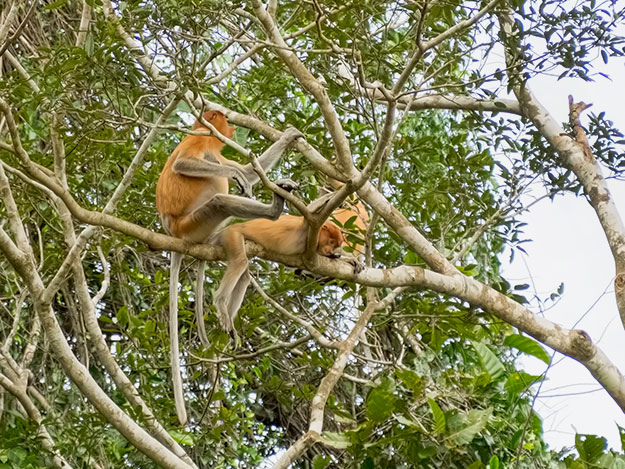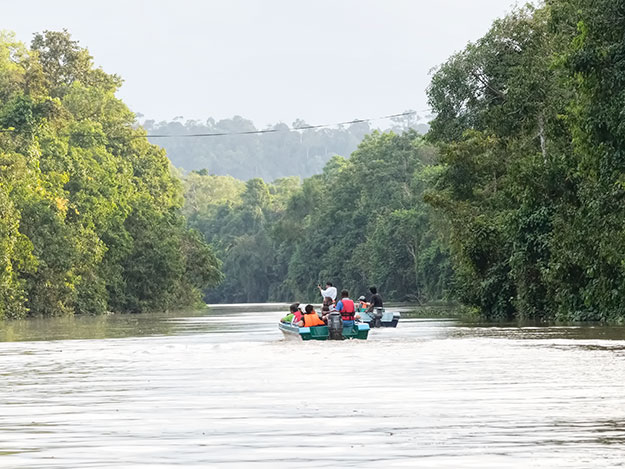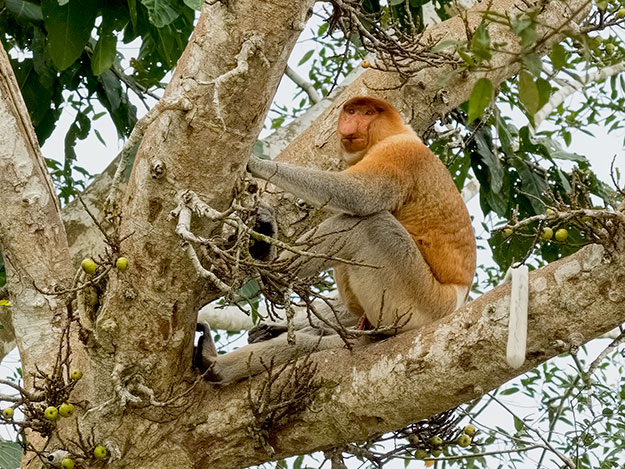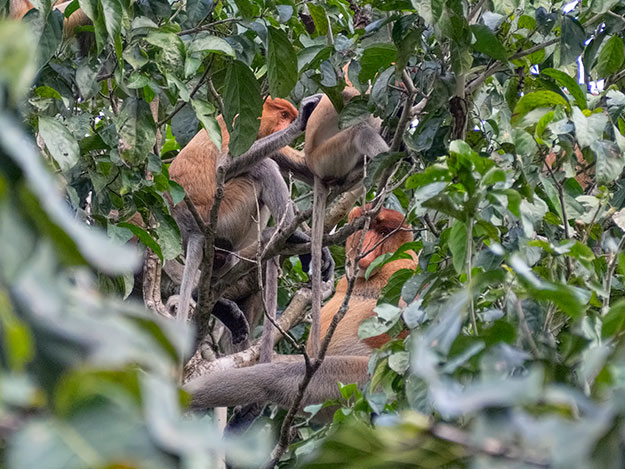“Take you to see proboscis monkey?” suggested the taxi drivers lined up at the entrance to the Sepilok Orangutan Rehabilitation Centre. Frankly, I had no idea what they were talking about. My visit to the Malaysian State of Sabah on the island of Borneo had two goals: see the endangered orangutans and sun bears. I’d never heard of proboscis monkeys, so later that afternoon I turned to Father Google. The moment I saw a photo of these strange primates, I knew I had to see them in the wild.

Found only on the island of Borneo, the proboscis monkey is among the largest species of primate and, like the orangutan and sun bear, it’s an endangered species. Males measure up to 30 inches in height and weigh up to 66 pounds, while females are slightly smaller. Their most startling features, however, are their huge noses and pot bellies. Females have perky, upturned noses, but the males have giant bulbous noses that measure up to four inches long. Intrigued, I signed up for a day trip to the Kinabatangan River and crossed my fingers for a successful sighting.

The following day I was picked up at my resort at noon for the two-hour drive to the river landing. Our group of eight donned life jackets and climbed into fiberglass boats with powerful motors, necessary for swerving around logs and piles of detritus floating down the swiftly flowing river. Our guide briefed us before jetting away from the pier. “I can’t guarantee we will see proboscis monkeys, because this is the jungle. They go where they go. But we’ll do our best to find them, and we’re usually successful.”

He need not have provided the disclaimer. Within 15 minutes the captain idled the engine and angled toward the shore. Our guide pointed to a cluster of tall trees. “Look for the bright orange color,” he shouted. Rustling leaves. A flash of orange. Suddenly, I saw one. Then two, then an entire family skittering around the branches. As the captain maneuvered closer, I was startled to see one huge male looking down on us with seeming disdain. Tucked into a crook of the tree, he reclined regally with one foot up on a branch. His big belly reminded me of my late Uncle Bee, who would inevitably fall asleep in a chair after Thanksgiving dinner, feet splayed, gut spilling over his belt, with a precariously tilted unfinished can of beer in one hand.

But it was the monkey’s enormous schnoz that most captivated me. Bulbous and red like an overindulgent alcoholic, it hung well below his mouth. How can they even eat, I wondered. I turned to the guide. “There must be some advantage to the big nose or they wouldn’t have evolved this way,” I said. The guide had no answers.

I later learned that scientists suspect the large nose allows the males to vocalize louder. Indeed, studies of the proboscis monkey in the wild have confirmed that the males with the largest nose always have the biggest harems. We saw many proboscis monkeys during that two-hour boat trip, but none more spectacular than the one I dubbed Uncle Bee.
That evening, I sent a photo of him to my sister, Linda, who is crazy about monkeys. I explained the theory about the big nose allowing the males to attract more females. She replied, “So, size does matter after all – LOL.” It would seem so!

I loved reading about your experience of seeing Proboscis monkeys. Your descriptions really made it come alive for me and I get to learn new knowledge from your blogs. Thanks for sharing!
Thanks so much for your lovely comment, Johanes. Glad you enjoyed about my monkey-spotting experience in Borneo.
I love these pictures Barbara. I also think of a few uncles who would load up on a heavy dinner then sleep it off; what a chill-looking dude. We are back in Thailand. See you soon 🙂
Just emailed you Ryan. I’m leaving soon on my spring tour, so hope we can get together before then.
We saw the proboscis monkeys up the Kinabatangan River too. The best views however were at Labuk Bay where they put out food twice a day and the locals turn up in family groups for the free food. Do you think the size of nose is related to the size of that other bright red appendage and that is what attracts the females to that particular male?
LOL, I don’t know, but they do say that the ones with the big noses have the largest harems.
Just added Borneo to my bucket list!
You’ll love it there Linda. We went in the August and seeing the grey mother langur monkeys with their little golden babies was my favourite. Borneo is also a very good place for bird watching if you are interested in birds. We also did a tour to the Gormantong Bat cave With added sight of various yucky bugs and an overpowering stench. (you sort of get used to it).
You’ll love it!